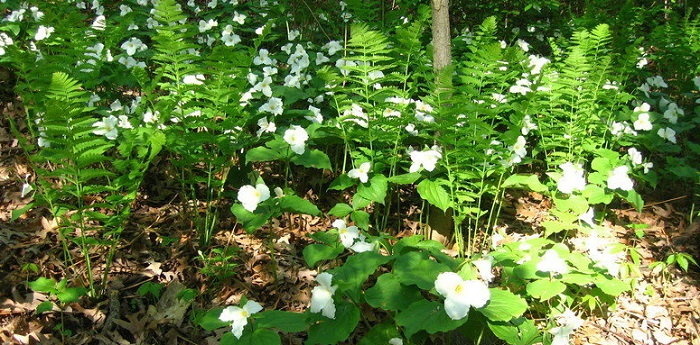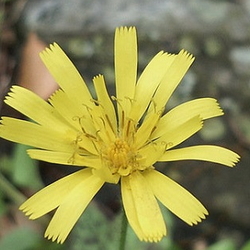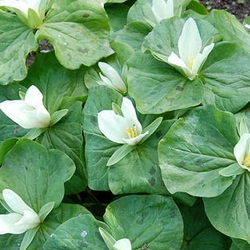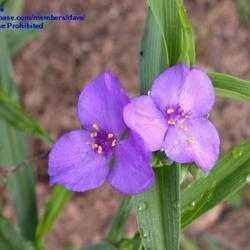Trillium graceful, Trillium white, Star of the woodland, lady of light
.....Milena Mateska
Growing up in the mountains as I did, it was a rare day in May that I didn't encounter a cluster of Trillium, those beautiful early spring flowers that leave us breathless with their simple beauty. I learned about them in early morning treks up the mountainside when I was a child. This is a story about a simple flower that often is left off the lists of the popular and the beautiful, and a bit of the mystery and lore that surrounds it. The white Trillium was the one that greeted me every spring, but it is just as lovely dressed in its other colors. It surprises me that little poetry is dedicated to this plant, but that could be because it hides itself very well, beneath the spreading limbs of the larger trees of the forest.
The Trillium that I know grows in the undisturbed shadow of forests located on the western edge of the Appalachian mountains. I discovered it one morning when I was on one one of my adventures with Aunt Bett. It was a morning in May, very early, and the dew was heavy enough to have dampened the rolled up legs of my jeans. We came upon a cluster of wonderful three petaled white flowers, and just below the three white petals were three green leaves. It was as magical as having a white carpet in front of us. But Aunt Bett said the flowers were sacred, and that we must not pick them.
We had not climbed that mountain in search of the Trillium that day, but we stopped when we got to them and she told me a story that lodged itself in my heart. The Trillium is a member of the lily family, she said, and Native American women treated the root of the plant as sacred. They gathered the root which was then made into a decoction and was used to treat the monthly discomfort that women often suffer. It was also regularly used to ease the pain of childbirth. The Native American warriors often carried the root of the Trillium with them as they went into battle, chewing it to give them added strength and protection. It was also considered to be a treatment for gangrene.

It was my mother who called the plant Trillium, Aunt Bett's name for it was Wake Robin. She said it appeared at about the same time the robins began to wake from the winter and make their first appearance to welcome spring. She told me that the flower was both edible and medicinal, but that it was a very fragile flower. The leaves can be cooked as a pot herb, and the root as a medicine was dried, made into a decoction and used as an antiseptic, a diuretic, and to cure eye or ear infections in addition to the methods used by the Native Americans. "But," said Aunt Bett, "the Wake Robin is not something that we are going to use because it is too sacred."
Now if you remember, I believed every word that fell from Aunt Bett's lips, but in this one instance, I asked why it was sacred. Aunt Bett told me this story....
"Three is a sacred number," she said. "Everything in the Bible is mentioned in threes. This here flower has three petals, it has three leaves and that is all that is on the single stem. If you pick the flower you pick the leaves too, and then the plant dies. If you pick all of the plants that you see here, then the cluster dies, and it will be many years before they will grow back." I asked her just how she knew that, which was obviously not a respectful thing to say to a Mountain Medicine woman. But instead of being angry that I questioned her, she told me a very sad secret, one that I always remembered. "When I was a young woman, I wanted to carry these flowers on my wedding day. I got up early that morning and filled a pail about half full of well water. I carried the pail with me on my way to pick the flowers. When I came to the spot on the mountainside where the WakeRobin grew, there were so many I got greedy and I filled my pail full of them. I carried them back down the mountain and back to my home. I began to fill jars with water so that I could set them around the room where the preacher was coming to marry us, but by the time I got ready to take the flowers out of the pail and put them into the jars, the flowers were wilted and were turning brown. They all turned brown and I had no flowers to carry into my marriage. You are old enough to hear this, girl. I think it was because I kilt the flowers that I was never able to have children. It took them flowers many, many years to come back again, and they didn't come back in the same place. It was because I had stole a sacred flower."
You know, that was the first time it occurred to me that Aunt Bett was not just a medicine woman. She was a woman who wanted children yet she blamed herself for never having had any. I remember being too timid to tell her that I was sorry, and she probably didn't want sympathy anyway, but that was the first time that I knew for sure that she might like me just a little bit, because as far as I knew she had told me a secret that she had carried in her heart for a long time. I felt a little different about her after that day, and I remember shedding a tear because she had been punished for touching a sacred flower.
What a sad thing to happen, I thought to myself, but I listened to what she had to say next: "Those flowers were meant to be picked only for those who are hungry and have nothing else to eat, or those who are sick and ain't got no other medicine. They are never to be used for any other purpose." Aunt Bett started on down the mountain, and of course, sad or not, I simply had to tempt the fates and pick one of the flowers, but only one because I planned to have children one day. I hoped maybe just one wouldn't count against me. I had a little water left in the fruit jar that I had brought with me so I placed the Trillium in it, slipped it back into the brown paper sack and went on down the mountain. Sure enough, when I got home, the Trillium was wilted and brown and I promised myself and the powers that be that I would never pick another Trillium. I have kept that promise, and I have two lovely children and one grandchild.
It wasn't until I was much older and saw these lovely flowers growing in a shaded area of a small field here in western Kentucky that I remembered Aunt Bett's story. Being always inquisitive and wanting to know why, I began to do a little research on the Trillium. It is a single stem which holds a swirl of three leaves, topped by a solitary 3 petaled flower. In the eastern US, most often the petals are white, but those found in the northern and western states can be purple and sometimes dark red. The medicinal qualities and herbal usages are just as Aunt Bett told me. The awe in which Aunt Bett held the plant, however, might be caused by the fact that the three leaves below the flower store the plant's only food. Once it has been cut, food no longer can make its way to the petals or to the stem, it immediately begins to wilt and turn brown.
The seeds of the Trillium are spread by mice and ants, territorial creatures, which is why the Trillium grows in clusters. Once a plant has been cut, it takes about seven years for it to recover, and it takes about fifteen years to grow from seed to bloom. Because of its fragility, some states have made it illegal to pick the Trillium.
The white Trillium is the emblem and official flower of Ontario, and it features prominently in the Franco Ontarian flag. This graceful flower with all its mystery is one of my favorites. It was named in the 1700's by Linnaeus who was known as the father of modern taxonomy. Of course Aunt Bett had no way of accumulating these facts. I doubt she had ever traveled very far outside her farm. He knowledge was inherited, handed down from a mother to a child. She was wise beyond her time in medicinal uses of plants, but was limited by the inability to delve into theories outside her realm of knowledge. Television had yet to make an appearance in the mountains and resource books were few and far between.
I always have to stop and take a closer look when I see a cluster of white flowers hoping always that they are Trillium. They grow low to the land, and look like a beautiful white carpet spread upon a forest floor. I have never seen them in a garden, and have never been able to transplant them successfully, though I am sure in this day and age it is entirely possible. When I do see them, I always remember that the Trillium is the flower that spoiled my Great Aunt Bett's wedding day, and that makes it sacred to me.
Images courtesy of PlantFiles


















